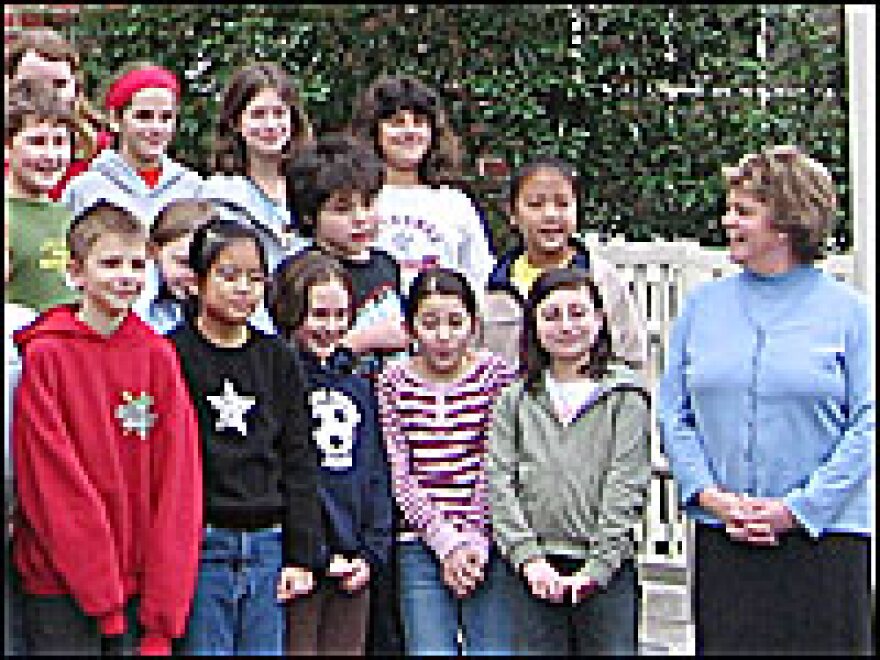

America's public schools spend billions of dollars each year trying to close the achievement gap between low-income and minority students, who score lower on tests, and white and affluent kids. Still, the gap persists.
In Seattle, the public school system's efforts to bridge that gap, despite limited resources, offer a window into the challenges facing school districts across the country.
As in most other big cities, vast inequities exist among Seattle's schools and neighborhoods. Parents in the district can choose any school. It's easy to see why many opt for Bryant Elementary, in the city's north end.
Only a handful of kids at Bryant qualify for a free or reduced-price lunch — the conventional yardstick for measuring poverty in education. Because Bryant has few children from poor families, it receives a mere $3,900 per student. Classes are large: Many have as many as 30 kids. Parents must pay if they want full-day kindergarten.
But Bryant parents contribute a lot, both in dollars and time. Speaking to parents of prospective students, Principal Linda Robinson explains how a strong Parent-Teacher-Student Association provides attractive enrichment programs.
"It is the computer lab, it is the new Yamaha keyboards in the music room, it's fifth-grade camp," Robinson says. "It is to coordinate our after-school homework center."
Robinson refers to Bryant as a "happy school." That applies to the kids and the teachers. Last school year, Bryant did not suspend a single student.
The Benefits of Experience and Community
Judy Towler doesn't need to waste much time on discipline; her fourth-graders settle down right away. Then she reads to them from Carl Hiaasen's book Flush. When it's time to go outside, they form a neat line behind her.
"This is definitely the kind of school where, if you land here, you know you do not want to leave here," Towler says. The students "come to school so ready to learn, they are so cooperative, and the parents are so supportive. And that's why I've stayed here 15 years, and I plan to retire from here."
Towler used to teach in a low-income school on the city's south end. She says day-to-day struggles there took a toll on her health. It got so bad she thought about leaving the profession, until her seniority helped get her a job at Bryant.
Not only does Bryant recruit more experienced teachers, it also draws on mentors from a well-educated cadre of parents and nearby hi-tech companies. Parents like Andrew Ching, who works for a biotechnology company that wanted to get involved in the community.
On a recent afternoon, Ching led a team of fourth- and fifth-graders as they tackled a question that has puzzled scientists for ages: How to get a grape juice stain out of a white T-shirt.
Ching's employer, ZymoGenetics, isn't the only company involved at Bryant. He says one of his company's rivals also sends volunteers.
"So it was a bit of a competition," Ching says. "We wanted to get more scientists involved."
Madrona Elementary: Trying to Help Struggling Students
Not all schools can count on such intense parental involvement.
Schools that draw students from lower-income families receive extra funds from the district. Madrona Elementary, a K-8 school in central Seattle, receives about $1,000 more per student than Bryant. That's in large part because 70 percent of its students are poor enough to qualify for free or reduced-price lunches.
Principal Kaaren Andrews greets students at the front door. At 6 feet tall, she has to bend double to give them hugs.
"You have a gold Panther shirt," she tells one youngster. The T-shirts with the school logo are coveted rewards for high-achievers at this school. "Give me a hug, Janelle. I am so proud of you. That's great!"
On this day, Andrews cajoles one reluctant student to attend an after-school program so he'll pass the state reading test. The student listens, but says he doesn't want to go. It's a tough sell, but Andrews keeps pushing. It takes a lot of time to persuade kids to take advantage of extra help. And it takes a lot of Andrews' time to make that help available. She writes grants, brings in outside experts, and basically does anything she can to boost performance.
Funding Needs and Teacher Pay
In her office, Andrews leafs through her budget. "Dollars are attached to kids, right?"
She explains how it works. The Seattle district gives Madrona extra money to deal with specific problems: poverty, students who are learning English, and those with special-education needs. Often, she ends up spending more than she receives.
For example, she says, the school gets $123,000 for special education. "And with that we have to buy a teacher, and an instructional assistant, and we have to buy all the supplies," she says. The money from the district won't cover it, forcing her to shift funds from other programs.
Language arts teacher Darice Johnson says Madrona students look to teachers for more than academics.
"You're the doctor, you're the nurse, you're the mom, you're the dad, you're the teacher, you're the psychologist," she says.
That drives some teachers away. Madrona has a less-experienced staff and higher turnover than Bryant.
Many districts offer financial incentives to lure experienced teachers to schools like Madrona that serve needy populations. But in Seattle, teachers get paid the same no matter where they work. Johnson says she's not sure whether that's fair or not. And she doesn't know whether other teachers would come to Madrona if they were paid more.
"They probably would," she says. "I would hope they would come here not just for the money, but for the love of it."
No Child Left Behind
The federal No Child Left Behind law has turned a spotlight on schools like Madrona. Test scores are monitored like the vital signs of a patient in intensive care.
Andrews requires teachers to submit a lesson plan for the entire week. She wants to know what they're doing and when. Some teachers appreciate her approach, but others have no desire to work in that kind of hothouse atmosphere.
Seattle's new academic officer, Carla Santorno, says the current emphasis on seniority pulls some teachers away from challenging schools. Santorno used to work in the Denver public schools, where teachers get what some refer to as "combat" pay: more money for moving to low-income schools. She wants Seattle to move in that direction.
"I think it totally makes sense to build a district culture that says, 'If you teach at Madrona, you must be a better teacher than when you teach at Bryant,'" she says.
By that logic, it takes a very special person indeed to teach at Rainier View Elementary, on Seattle's southern edge.
Rainier View Elementary: Supporting the Neediest Students
Rainier principal Cathy Thompson greets her students with enthusiasm: "Welcome to school! And happy Valentine's Day! I hope you're looking forward to a positive day today. I know I am."
Thompson says she likes Valentine's Day because it's a culturally neutral holiday, one she feels comfortable sharing with her very diverse bunch of students. Somali refugees are the biggest minority group at Rainier. Each class contains a smattering of girls in elaborately decorated headscarves.
The school gets about $6,100 per student, compared with $3,900 at Bryant Elementary. The extra money helps reduce class sizes, but it does not produce test scores even close to those at Bryant. Only one out of three fourth-graders at Rainier can pass the state's basic math test.
So, Thompson says, the school is focusing on something she believes is more important than money: "The relationship that occurs between a teacher and a child, or between the school and the family, is absolutely critical to the child's ability to learn."
Rainier is part of Seattle's latest effort to fight the achievement gap, called the "Flight School" program. Its goal is to provide low-income children with a seamless track to high school — and maybe even college. Teachers visit students' homes to learn more about the cultures they come from, to help the school better support its students.
It's too soon to say whether the Flight School program has helped. But Thompson and her teachers worry that all their efforts may not matter: Rainier View Elementary is closing.
Early one morning, Thompson gathers teachers and staff in the school library to discuss how to pack up before the school shuts down at the end of the year. The reasons for the closure are complex, but the impact on students and staff is immediate. And teachers like Zoe McGuire don't like it.
"We show up to work on Monday, and there's the dumpsters," she says, choking up with emotion. "And I wonder, where is the support for our families and for our kids?"
How, she asks, will she protect her students from the trauma of the move? Most will go to another school, but many teachers here don't have much seniority, so they'll wind up scattered around the district.
As the meeting breaks up, McGuire says the looming closure is disrupting every facet of school life, and the disruption is worse for students who are already far behind.
"There's no support for how to go through this," she says.
Copyright 2023 NPR. To see more, visit https://www.npr.org.




